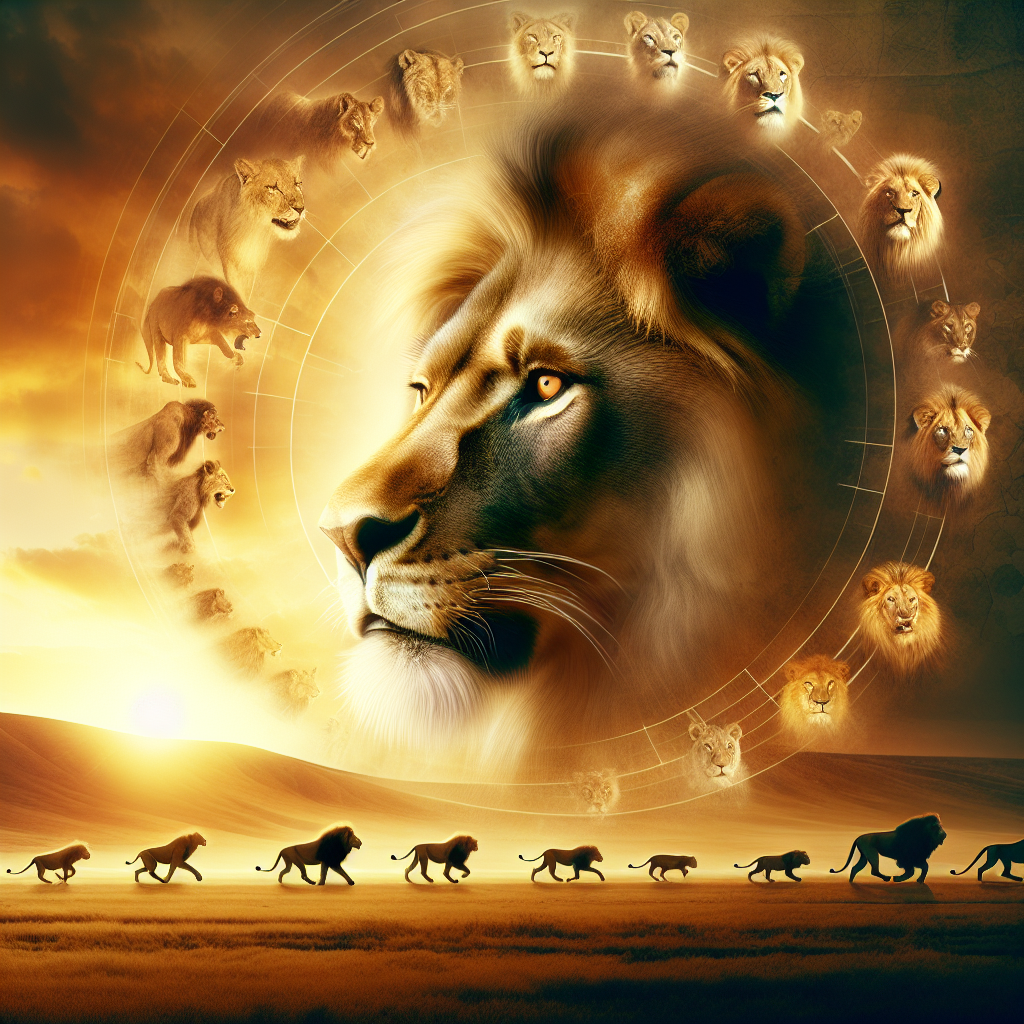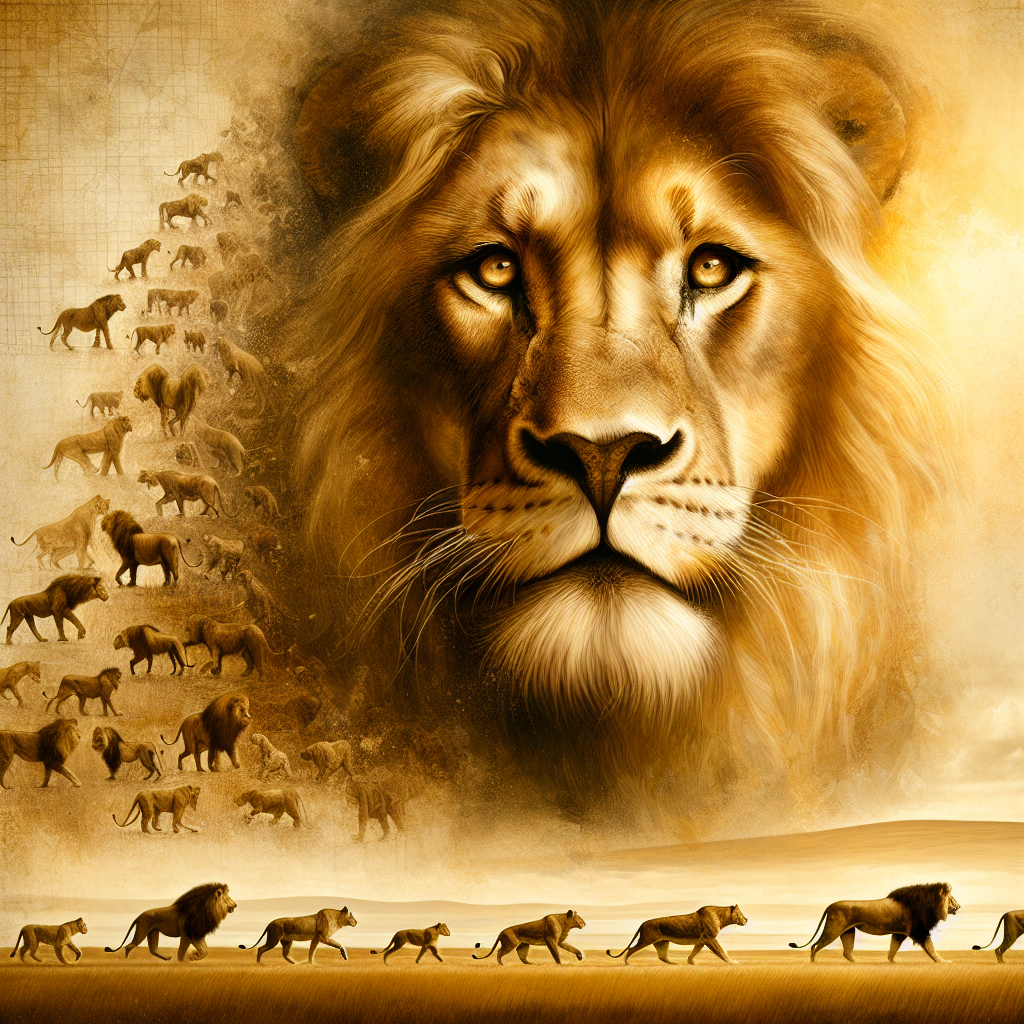Alright, so picture this: you’re out in the wild savannah, the sun beating down on you. In the distance, you hear the roar of a lion, the king of the jungle. But have you ever wondered how these majestic creatures came to be? In this article, we’ll take a deep dive into the evolutionary journey of lions and their ancestors, uncovering the fascinating story of their rise to the top of the food chain. Get ready to learn a thing or two about the origins of these magnificent beasts.

Lions: The King of the Jungle
Introduction to lions
Lions, with their majestic presence and powerful roar, have captured the imagination of humans for centuries. These regal creatures, known as the “King of the Jungle,” are a symbol of strength, courage, and power. In this article, we will explore the ancestry of lions, their physical characteristics, behavior, and lifestyle, as well as their interactions with humans and the challenges they face in the modern world.
Physical characteristics of lions
Lions are one of the largest members of the Felidae family, with males weighing up to 550 pounds and measuring around 8 feet in length, including their tail. These magnificent creatures are characterized by their muscular build, golden-brown fur, and a majestic mane that distinguishes the males from the females. The mane not only serves to enhance their appearance but also plays a role in social signaling and protection during fights.
Lion behavior and lifestyle
Lions are highly social animals, forming groups called prides consisting of related lionesses, their cubs, and a few dominant males. The pride serves as a tightly knit social unit, with lionesses usually forming the core of the group and working together to raise the cubs, hunt, and defend their territory. Male lions, on the other hand, play a crucial role in protecting the pride and ensuring its survival.
Ancestry of Lions
Origins of the Felidae family
The Felidae family, which includes lions, tigers, leopards, and other wild cats, originated around 25 million years ago. These feline creatures have evolved over time to adapt to their diverse habitats and lifestyles. Lions, in particular, have undergone significant evolutionary changes to become the apex predators they are today.
Prehistoric predecessors of lions
Before the modern lions we know, there existed a varied array of prehistoric lions that roamed the Earth. These ancient relatives, such as the American lion and the Eurasian cave lion, were larger and stouter than their modern counterparts. They exhibited adaptations specific to their respective environments, giving us a glimpse into the complexity of lion evolution.
Evolutionary timeline
The evolutionary journey of lions can be traced back millions of years, with fossil evidence and genetic studies providing valuable insights. From the early Felidae ancestors to the prehistoric sabertooth cats, each stage of the evolutionary timeline contributed to the development of the majestic African lion we know today.
Prehistoric Relatives: The Sabertooth Connection
Introduction to sabertooth cats
The connection between modern lions and their prehistoric relatives, the sabertooth cats, is an intriguing aspect of lion evolution. Sabertooth cats, known for their iconic long, curved canines, roamed the Earth during the Pleistocene epoch. While they were not direct ancestors of lions, their shared lineage highlights the diversity of the Felidae family.
Relation to modern lions
The sabertooth cats and lions shared similarities in their bone structure and evolutionary adaptations. Both were apex predators, but their hunting techniques and ecological niches differed. Understanding the adaptations of sabertooth cats can provide valuable insights into the evolution of lions and their own unique set of skills.
Key adaptations of sabertooth cats
Sabertooth cats had several distinctive adaptations that set them apart from modern lions. Their elongated canines, for example, were engineered to deliver a devastating bite to their prey. Additionally, their robust body structure and specialized jaw joints allowed them to tackle larger prey, as opposed to the cooperative hunting practices of lions. These adaptations played a crucial role in the success of sabertooth cats during their time.
Pleistocene Giants: The Cave Lion
Overview of the cave lion
The cave lion, also known as Panthera leo spelea, was a subspecies of lion that lived during the Pleistocene epoch. These magnificent creatures were found throughout Europe, Siberia, and North America and are believed to be closely related to the modern African lion.
Habitat and distribution
Cave lions inhabited a wide range of environments, including open grasslands and forests, adapting to different climates and terrains. Their fossils have been discovered in various regions, suggesting a once vast distribution across the globe.
Physical characteristics and adaptations
The cave lion was notably larger and stronger than today’s African lion. They had a more robust skeleton, which allowed them to tackle larger prey and survive in colder habitats. The cave lion adapted to living in caves, as evidenced by their name, and likely had a thicker coat to withstand harsh conditions.

African Lion: The Modern Species
Introduction to African lions
The African lion, scientifically known as Panthera leo, is the only lion species still surviving in the wild. These mighty creatures are primarily found in sub-Saharan Africa, where they roam the vast grasslands, woodlands, and savannahs, captivating tourists and locals alike.
Geographical distribution
African lions have a broad geographic distribution, with populations scattered across 26 countries in Africa. They can be found from Senegal in West Africa to Ethiopia and South Sudan in the east, and down to South Africa. Each population faces unique challenges and is adapted to the specific environment in which they reside.
Population status and conservation
Unfortunately, the African lion population has been steadily declining over the years due to habitat loss, poaching, and human-wildlife conflicts. In response to this threat, conservation organizations and initiatives have been working tirelessly to protect and conserve these magnificent creatures and their habitats, ensuring their survival for future generations.
Social Structure and Hunting Strategies
Lion pride and social hierarchy
Lions exhibit a complex social structure centered around a pride. The pride consists of a dominant male, several lionesses, and their cubs. Each member of the pride plays a specific role, contributing to the overall functioning and success of the group.
Roles of male and female lions
Male lions are responsible for protecting the pride and its territory from rival males while also contributing to hunting when necessary. Lionesses, on the other hand, are the primary hunters, displaying remarkable teamwork and coordination during hunts. The females work together to bring down large prey, providing nourishment for the entire pride.
Hunting techniques and cooperative behavior
Lions employ a combination of stealth, strength, and teamwork during hunting. They are adept at stalking their prey, using the cover of vegetation or darkness to their advantage. Once within striking distance, they launch a coordinated attack, utilizing their powerful jaws to deliver a lethal bite. Cooperative hunting allows lions to take down larger prey, and their success rate is often influenced by the size of the pride and the availability of suitable prey.
Adaptations for Survival
Physical adaptations for hunting
Lions have various physical adaptations that enable them to hunt successfully. Their muscular build and powerful forelimbs provide the strength needed to bring down large prey, while their sharp claws and teeth are instrumental in seizing and dispatching their victims. Additionally, their flexible spine and strong hindquarters allow for agility and quick bursts of speed during chases.
Camouflage and protective features
The golden-brown coat of lions serves as an effective form of camouflage, blending in with the savannah grasses and providing some concealment during hunts. Their tufted tails play a crucial role in communication and visual signaling, aiding in social interactions and maintaining the cohesion of the pride.
Behavioral adaptations for survival
Lions have developed various behavioral adaptations to improve their chances of survival. Their roaring serves to communicate with other pride members, assert dominance, and warn off potential rivals. Additionally, their social structure and cooperative hunting techniques allow them to overcome the challenges of hunting large prey and defending their territory against threats.
Lion Conservation Efforts
Threats to lion populations
Lion populations face numerous threats, primarily driven by human activities. Habitat loss and fragmentation, poaching for bushmeat and trophies, retaliatory killings due to human-wildlife conflicts, and the illegal wildlife trade all contribute to the decline of lion populations across Africa. These threats underscore the urgent need for conservation efforts and sustainable solutions.
Conservation organizations and initiatives
To combat the declining lion population, numerous conservation organizations and initiatives have been established. These organizations focus on various aspects of lion conservation, including community engagement, anti-poaching efforts, habitat protection, and research. Through collaborative efforts, these organizations aim to ensure the long-term survival of lions in the wild.
Success stories and ongoing challenges
Despite the challenges, there have been some success stories in lion conservation. Efforts such as the establishment of protected areas, community-based conservation programs, and innovative conservation techniques have led to increases in lion populations in certain regions. However, ongoing challenges, such as political instability, lack of funding, and the need for increased awareness and education, continue to pose obstacles to effective lion conservation.
Interactions with Humans
Cultural significance of lions
Lions hold deep cultural significance in many societies and have been revered and feared for centuries. They often symbolize strength, courage, and nobility and have inspired myths, folklore, and religious beliefs across cultures. From ancient Egypt to India and beyond, lions have left an indelible mark on human civilization.
Mythology and symbolism
In various mythologies and religions, lions are often associated with deities, seen as protectors or symbols of power and royalty. The lion’s mane, in particular, is believed to represent wisdom and divine presence. These cultural associations have helped shape the perception of lions and their place in human society.
Human-lion conflicts and coexistence
As human populations expand and encroach upon lion habitats, conflicts between humans and lions have become more frequent. Livestock predation, crop raiding, and the occasional attacks on humans have created tension and hostility towards lions. Finding ways to mitigate these conflicts and promote peaceful coexistence between humans and lions is crucial for the long-term survival of both.
The Future of Lions
Climate change and its impact
Climate change poses a significant threat to lions and their habitats. Rising temperatures, changes in rainfall patterns, and habitat degradation can disrupt ecosystems and affect the availability of prey. Lions, as top predators, are particularly vulnerable to these changes, and their survival depends on proactive measures to mitigate and adapt to the impacts of climate change.
Prospects for reintroduction
Reintroduction programs, aimed at reintroducing lions to areas where they have become locally extinct, hold promise for the future of lion conservation. By restoring populations to their historical ranges, these programs aim to reestablish ecological balance and provide opportunities for the long-term survival and genetic diversity of lion populations.
Long-term survival strategies
Ensuring the long-term survival of lions requires a multi-faceted approach. Effective habitat protection, anti-poaching measures, community involvement, and education are essential components of any successful lion conservation strategy. Collaboration between governments, conservation organizations, local communities, and researchers will be vital in safeguarding the future of these iconic animals.
In conclusion, the evolutionary journey of lions and their ancestors has shaped one of the most iconic and revered creatures on Earth. From prehistoric sabertooth cats to the modern African lion, these majestic predators have adapted to diverse environments and developed unique social structures and hunting strategies. However, lions face numerous threats, including habitat loss, poaching, and human-wildlife conflicts. Comprehensive conservation efforts and a commitment to coexistence are crucial to ensuring the long-term survival of these magnificent animals. With proactive measures and continued research, we can work towards a future where lions continue to reign over the savannah and inspire awe and admiration in our hearts.

